Related Research Articles

Cyberpunk is a subgenre of science fiction in a dystopian futuristic setting that tends to focus on a "combination of lowlife and high tech", featuring futuristic technological and scientific achievements, such as artificial intelligence and cyberware, juxtaposed with societal collapse, dystopia or decay. Much of cyberpunk is rooted in the New Wave science fiction movement of the 1960s and 1970s, when writers like Philip K. Dick, Michael Moorcock, Roger Zelazny, John Brunner, J. G. Ballard, Philip José Farmer and Harlan Ellison examined the impact of drug culture, technology, and the sexual revolution while avoiding the utopian tendencies of earlier science fiction.

Philip Kindred Dick, often referred to by his initials PKD, was an American science fiction writer. He wrote 44 novels and about 121 short stories, most of which appeared in science fiction magazines during his lifetime. His fiction explored varied philosophical and social questions such as the nature of reality, perception, human nature, and identity, and commonly featured characters struggling against elements such as alternate realities, illusory environments, monopolistic corporations, drug abuse, authoritarian governments, and altered states of consciousness. He is considered one of the most important figures in 20th century science fiction.
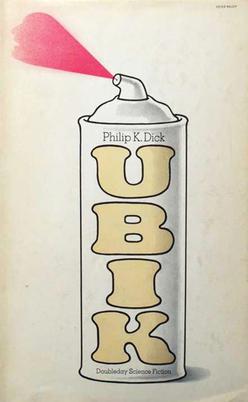
Ubik is a 1969 science fiction novel by American writer Philip K. Dick. The story is set in a future 1992 where psychic powers are utilized in corporate espionage, while cryonic technology allows recently deceased people to be maintained in a lengthy state of hibernation. It follows Joe Chip, a technician at a psychic agency who begins to experience strange alterations in reality that can be temporarily reversed by a mysterious store-bought substance called Ubik. This work expands upon characters and concepts previously introduced in the vignette "What the Dead Men Say".

Do Androids Dream of Electric Sheep? is a dystopian science fiction novel by American writer Philip K. Dick, first published in 1968. The novel is set in a post-apocalyptic San Francisco, where Earth's life has been greatly damaged by a nuclear global war, leaving most animal species endangered or extinct. The main plot follows Rick Deckard, a bounty hunter who has to "retire" six escaped Nexus-6 model androids, while a secondary plot follows John Isidore, a man of sub-par IQ who aids the fugitive androids.
"We Can Remember It for You Wholesale" is a science fiction novelette by American writer Philip K. Dick, first published in The Magazine of Fantasy & Science Fiction in April 1966. It features a melding of reality, false memory, and real memory. The story was adapted into the 1990 film Total Recall with Arnold Schwarzenegger as the story's protagonist; that film was remade in 2012 with Colin Farrell as the protagonist.
"The Father-Thing" is a 1954 science fiction short story by American writer Philip K. Dick. The story, told through third-person narration but focusing on the child, concerns the replacement of a boy's father with a replicated version. At first, only the child sees the difference and has to recruit other children to help him reveal the truth. The story is typical of Dick's short stories of the period.
"Null-O" is a 1958 science fiction short story by American writer Philip K. Dick. It examines the concept of totally unempathic and 'logical' humans ("Null-Os") in a parody of the plot and concepts of The Pawns of Null-A by A. E. van Vogt. These beings view individual collections of matter, i.e. any object, as subjective structures and see the true state of reality as an 'undifferentiated world of pure energy'. They can also move their ears independently, giving them excellent hearing. After attaining positions of power they proceed with a plan to ultimately return everything in the universe to this state. This is to be done by the construction of successively more powerful bombs, ultimately resulting in the rather improbable 'U-bomb' that will homogenise the whole universe. The Null-O plan is halted, however, when the 'ordinary' people of the world, who have survived the nuclear destruction of Earth's surface in the shelters built by their employers, rise up in drilling machines to stop the construction of an 'E-Bomb' designed to destroy Earth, and succeed in destroying both the E-Bomb prototype and the Null-O's themselves.
"The Electric Ant" is a science fiction short story by American writer Philip K. Dick. It was first published in Fantasy and Science Fiction magazine in October 1969.
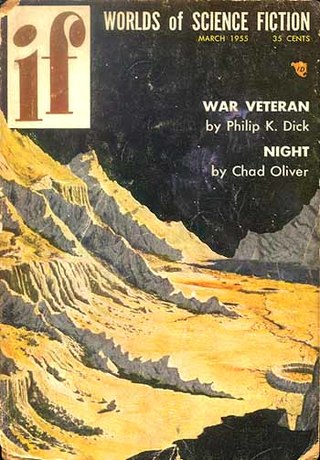
"War Veteran" is a science fiction short story by American writer Philip K. Dick. It was first published in If magazine in March 1955.
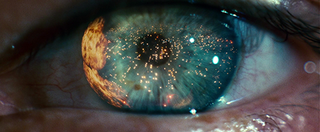
Despite the initial appearance of an action film, Blade Runner operates on an unusually rich number of dramatic levels. As with much of the cyberpunk genre, it owes a large debt to film noir, containing and exploring such conventions as the femme fatale, a Chandleresque first-person narration in the Theatrical Version, the questionable moral outlook of the hero—extended here to include even the literal humanity of the hero, as well as the usual dark and shadowy cinematography.
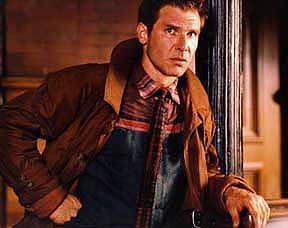
Rick Deckard is a fictional character and the protagonist of Philip K. Dick's 1968 novel Do Androids Dream of Electric Sheep?. Harrison Ford portrayed the character in the 1982 film adaptation, Blade Runner, and reprised his role in the 2017 sequel, Blade Runner 2049. James Purefoy voiced the character in the 2014 BBC Radio 4 adaptation.
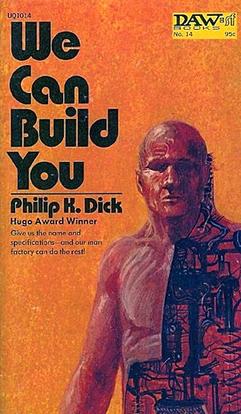
We Can Build You is a 1972 science fiction novel by American writer Philip K. Dick. Written in 1962 as The First in Our Family, it remained unpublished until appearing in serial form as A. Lincoln, Simulacrum in the November 1969 and January 1970 issues of Amazing Stories magazine, re-titled by editor Ted White. The novel was issued as a mass market paperback original by DAW Books in 1972, its final title provided by publisher Donald A. Wollheim. Its first hardcover edition was published in Italy in 1976, and Vintage issued a trade paperback in 1994.
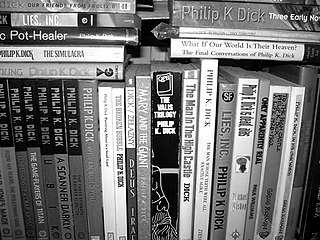
The bibliography of Philip K. Dick includes 44 novels, 121 short stories, and 14 short story collections published by American science fiction author Philip K. Dick during his lifetime.
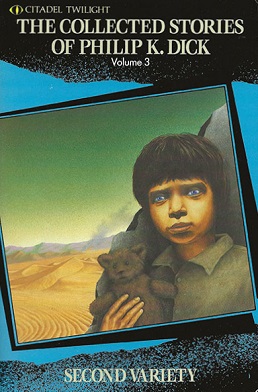
Second Variety is a collection of science fiction stories by American writer Philip K. Dick. It was first published by Citadel Twilight in 1991 and reprints Volume III of The Collected Stories of Philip K. Dick with the addition of the story "Second Variety". Many of the stories had originally appeared in the magazines If, Science Fiction Adventures, Science Fiction Stories, Orbit, Fantasy and Science Fiction, Imagination, Future, Galaxy Science Fiction, Beyond Fantasy Fiction, Satellite, Science Fiction Quarterly, Imaginative Tales and Space Science Fiction. There is huge overlap with the 1997 The Philip K. Dick Reader: stories 1–20 and 24 are identical.

"The Commuter" is a science fiction short story by American writer Philip K. Dick, first published in the August-September 1953 issue of Amazing Stories. It has been reprinted over 20 times, including Croatian, Dutch, French, German and Italian translations. As with much of Dick's fiction, it is an exploration of the boundary of existence.
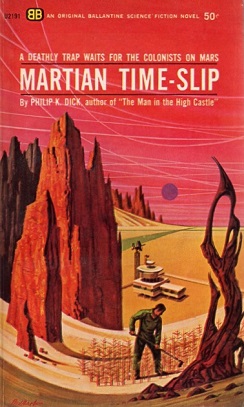
Martian Time-Slip is a 1964 science fiction novel by American writer Philip K. Dick. The novel uses the common science fiction concept of a human colony on Mars. However, it also includes the themes of mental illness, the physics of time and the dangers of centralized authority.
"The Unreconstructed M" is a science fiction novelette by Philip K. Dick, first published in the January 1957 issue of Science Fiction Stories and later in The Minority Report. The story is in the public domain. In it, an independent researcher uncovers a plot to falsify evidence in a world where the technology used to solve crimes has advanced.
Isa Dick Hackett is an American producer and writer for Amazon who helped produce The Man in the High Castle, Philip K. Dick's Electric Dreams, and The Adjustment Bureau, all of which are based on works by her father, Philip K. Dick.
"The Hanging Stranger" is a science fiction short story by American writer Philip K. Dick, originally published in December 1953 in the magazine Science Fiction Adventures. It has been reprinted in several anthologies, and published in French, Italian and German. It was adapted by Dee Rees into the episode "Kill All Others" or "K.A.O." for the 2017 television series Philip K. Dick's Electric Dreams. A book was also released to republish "The Hanging Stranger" along with the nine other stories on which the Electric Dreams episodes were based.

"The Impossible Planet" is a science fiction short story by American writer Philip K. Dick, first published in the October 1953 issue of Imagination. It has been reprinted over 30 times, including Brian Aldiss's 1974 Space Odysseys anthology. It was also published in Dutch, French, German and Italian translations. The writer originally submitted it to the Scott Meredith Literary Agency on February 11, 1953, with the title "Legend."
References
- ↑ "Exhibit Piece by Philip K. Dick is PUBLIC DOMAIN : SFFaudio". www.sffaudio.com. Retrieved 2017-10-24.
- ↑ "Exhibit Piece". Philip K. Dick Review. 2014-05-17. Retrieved 2017-10-24.
- ↑ Griffiths, Eleanor Bley (15 October 2017). "Electric Dreams: real Life – how does the TV show compare to Philip K Dick's original story?". Radio Times. Retrieved 26 October 2017.